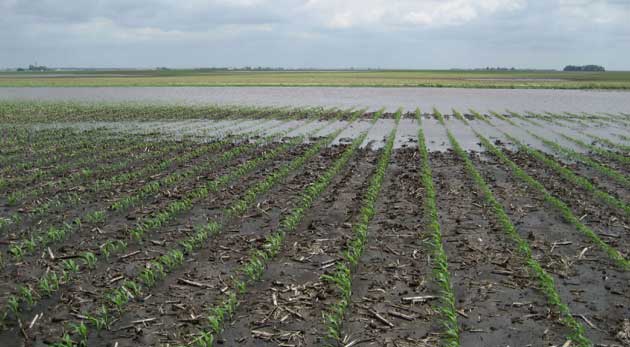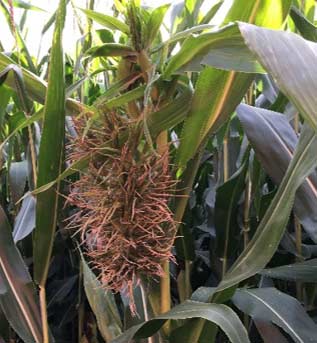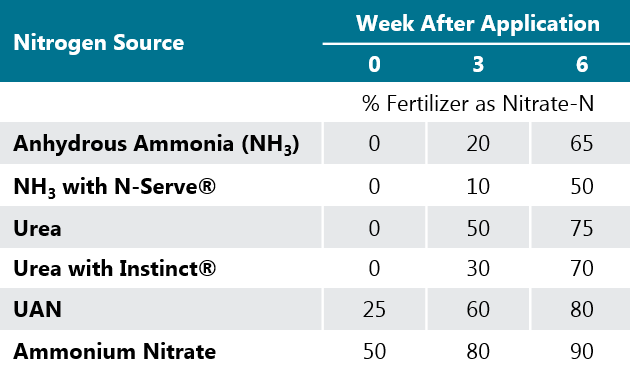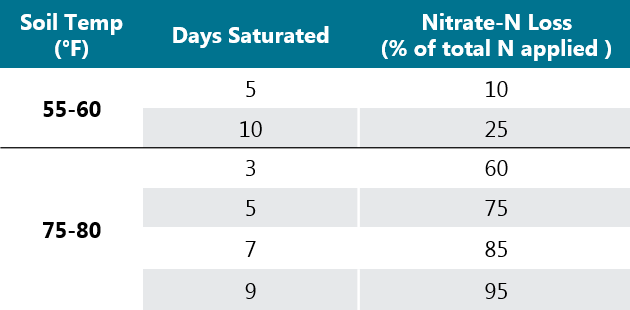Key Points
- Flooding damages growing corn by depriving plant cells of oxygen needed for respiration.
- The extent of damage depends on crop growth stage, duration of flooding, and air/soil temperature.
- Soils that have been saturated for 2 to 3 days are susceptible to nitrogen loss through denitrification.
Flooding Effects on Corn
- Heavy and persistent spring rains can create saturated or flooded soil conditions that can injure or kill growing corn.
- Flooding reduces the exchange of air between the atmosphere and the soil, which damages corn plants by depriving plant tissues of oxygen required for respiration.
- Macro- and micropores comprise 40-50% of the volume of an undisturbed, well-granulated silt loam soil.
- At field capacity, about half of this space will occupied by air and the other half by water. At saturation, pore space is completely filled by water (Figure 1).
- Damage can occur even if there is no standing water on the surface as long as the soil pore space remains saturated.

Figure 1. Volumes of water and air associated with soil pores in 100 grams of a well-granulated silt loam soil at saturation and field capacity.
Flooding Starves the Roots of Oxygen
- Cellular respiration provides energy and carbon necessary for maintenance and growth by oxidizing photoassimilates.
- Oxygen deprivation in flooded soil reduces the rate of respiration, depleting plant tissues of energy and carbon necessary to carry out essential physiological processes.
- This leads to restricted root growth, reduction in transport of water and nutrients through the roots to the shoot, and eventually cell, root, and plant death.
- Under anaerobic conditions, mitochondrial respiration and metabolism shifts to fermentation. This process produces a small amount of energy but also creates lactic acid, ethanol, and acetaldehyde, which are harmful to plants.

Factors That Influence Flooding Damage
Duration of Flooding
- The longer the soil remains flooded or saturated, the greater the damage to the growing corn will be.
- If flooding only persists for a few hours, effects on the plant can be reversed and long-term damage will likely be minimal.
- The oxygen supply in flooded soil will be depleted within 24 to 48 hours.
- Corn below the V6 growth stage can generally survive 1 to 4 days of flooding, depending on temperature.
- Plants have a greater chance of survival if the growing point is not fully submerged or is submerged for less than 2 days.
Temperature
- Warmer temperatures decrease the amount of time that corn can survive flooding.
- Respiration is a temperature-dependent reaction. Warmer temperatures increase the rate of respiration, which accelerates the depletion of oxygen and buildup of harmful compounds.
- Approx. duration of flooding corn can survive, by temperature:
- Upper 70s or warmer = 1 day or less
- Upper-60s to mid-70s = ~2 days
- Mid-60 or cooler = ~4 days
Crop Growth Stage
- Corn below the V6 growth stage is more susceptible to flooding than larger corn.
- The corn plant's growing point is below ground until about V6
- Younger plants and tissues have a higher rate of respiration due to the demands of rapidly dividing and enlarging cells.
- Older plants have larger and deeper root systems that are more resilient against flooding damage.
Assessing Flooding Damage to Corn
- After flooding subsides, evaluate plant survival by examining the growing point of plants:
- Growing point tissue should be white to cream colored
- Darkening and softening usually precedes plant death
- Surviving plants should resume new leaf growth within 3 to 5 days after water drains from the field.
- Even if plants survive, long-term growth and performance can be negatively affected.
- Plants injured by flooding early in the season can be more susceptible to dry conditions later in the summer due to reduced root development.
Crazy Top in Corn

- Plants that are flooded early in the season are susceptible to a disease known as crazy top.
- Crazy top is caused by Sclerophthora macrospora, an oomycete pathogen that infects the growing point of submerged corn plants.
Nitrogen Loss From Flooding
- Heavy rainfall and highly saturated soils early in the season can cause loss of fall- or spring-applied nitrogen from the soil.
- Nitrogen loss potential is directly related to the amount of nitrogen in the nitrate form (Table 1). Nitrate (NO3-) is the form of nitrogen most readily taken up by the plant, but it is also the form with the greatest risk for loss.
- Nitrogen in the ammonia (NH3) or ammonium (NH4+) form binds to negatively charged soil particles, protecting it from water-induced losses.
- Ammonium is converted to nitrate in a bacteria-mediated transformation called nitrification.
Table 1. Proportion of nitrogen fertilizer in the nitrate-N form 0, 3 and 6 weeks after spring application (Lee et al., 2007).

Mechanisms of Nitrogen Loss
- Nitrate may be lost from the soil either by leaching or denitrification, depending primarily on soil characteristics.
- Coarse-textured soils allow water and nitrate to move readily downward through the soil profile. When this leaching places nitrate below the root zone, it is no longer accessible to plants.
- Fine-textured soils, on the other hand, have capillary pores that hold water tightly, restricting its downward movement.
- In this situation, saturated soils and anaerobic conditions may result in nitrate being lost upward to the atmosphere through denitrification.
- Denitrification is the process by which nitrate is converted to nitrogen gas by soil bacteria. Two to three days of soil saturation are required for bacteria to begin denitrification.
- Nitrogen loss from denitrification is influenced by duration of soil saturation and soil temperature (Table 2).
Table 2. Estimated denitrification losses as influenced by soil temperature and days of saturation (Bremner and Shaw, 1958).

Measuring Nitrogen Loss
- Determining whether or not additional nitrogen is needed can be difficult.
- Nitrogen soil tests can help provide an estimate of nitrogen needs.
- The most commonly recommended and used soil-testing procedure for nitrogen is the pre-sidedress nitrate test (PSNT)
- This test also has limitations and specific applications, so adjustments may be required.
- The critical level may need to be adjusted above 25 ppm when using the PSNT for determining N availability following heavy rains.
- Some labs prefer to do a total nitrogen test assessing both ammonium and nitrate levels.
References
- Bremner, J.M. and K. Shaw, 1958. Denitrification in soil. II. factors affecting denitrification. Journal of Agricultural Science (Cambridge) 51:40.
- Lee, C., J. Herbek, G. Schwab, and L. Murdock. 2007. Evaluating flood damage in corn. University of Kentucky Cooperative Extension Service Publication AGR-193.
Authors: Mark Jeschke
The foregoing is provided for informational use only. Please contact your Pioneer sales professional for information and suggestions specific to your operation. Product performance is variable and depends on many factors such as moisture and heat stress, soil type, management practices and environmental stress as well as disease and pest pressures. Individual results may vary..
April 2020